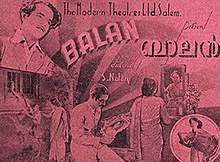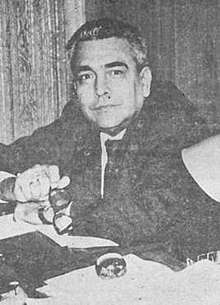Balan (film)
Balan is a 1938 Indian Malayalam-language film directed by S. Nottani.[2] It was the third feature film (after Vigathakumaran and Marthanda Varma) and first sound film in Malayalam.[3][4][5] Based on the short story "Vidhiyum Mrs. Nayarum" by A. Sundaram, its screenplay and dialogues are written by Muthukulam Raghavan Pillai. The film is a melodrama and was the first movie in this genre in Malayalam. It is produced by T. R. Sundaram of Modern Theatres, Salem.[4] The film, which stars K. K. Aroor, Master Madanagopal, M. V. Shanku, K. Gopinath, Alleppey Vincent, C. O. N. Nambiar, M. K. Kamalam, K. N. Lakshmi, Baby Malathi, A. B. Pious and Subhadra, is about the struggle of two orphaned children.[6] German cinematographer Bado Gushwalker handled the camera while Varghese and K.D. George did the editing. Its music was composed by K. K. Aroor and Ibrahim. There are overall 23 songs in the film.
| Balan | |
|---|---|
 A poster of Balan | |
| Directed by | S. Nottani |
| Produced by | T. R. Sundaram |
| Screenplay by | Muthukulam Raghavan Pillai |
| Based on | "Vidhiyum Mrs. Nayarum" by A. Sundaram |
| Starring | K. K. Aroor M. K. Kamalam Master Madanagopal M. V. Shanku K. Gopinath Alleppey Vincent C. O. N. Nambiar K. N. Lakshmi Baby Malathi |
| Music by | K. K. Aroor Ibrahim |
| Cinematography | Bado Gushwalker |
| Edited by | Varghese and K.D. George |
Production company | |
| Distributed by | Shyamala Pictures |
Release date |
|
| Country | India |
| Language | Malayalam |
The film was a milestone in Malayalam film history, not only for being the second talkie, but also for being one of the first commercially successful films.[7] Through the film, Alleppey Vincent became the first "speaking person" of Malayalam cinema, K. K. Aroor the first "speaking hero" and M. K. Kamalam the first "speaking heroine". "Hello Mister" was the first recorded sound, which was in the voice of Alleppey Vincent.
The film is lost; only the songs book and a few stills survive to this day.[7]
Plot
Cast
- Master Madanagopal as young Balan
- M. V. Shankar as Dr. Govindan Nair
- K. Gopinath as Kittu Panicker
- Alleppey Vincent as Shanku
- C. O. N. Nambiar as Prabhakara Menon
- K.N. Laxmikutty as Meenakshi
- Baby Malathi as young Sarasa
- A. B. Pious
- Subhadra
- Ammu
- M.K.K Nambyar
- Sivanandan
- Parukkutty
- Baby Kausalya
- A. P Padmanabha Menon
Production
There were several attempts to make a talkie in Malayalam, right from the days Vigathakumaran (1928) got released. One among them, A. Sundaram Pillai, had an unpublished story entitled Vidhiyum Mrs. Nayarum (Mrs. Nair and the Fate) with him. He contacted several production houses to adapt this story into a film. Several of his attempts failed, but at last he got a letter from T. R. Sundaram, a Tamil-based producer informing him that he was ready to produce the film.[8] T. R. Sundaram owned the production company Modern Theatres, which he established in 1936.[8] A. Sundaram had already finished casting, which included several theatre artists from Malayalam. K. Kunjunair, credited as K. K. Aroor in the film, of the Kottakkal Nataka Samithi was selected to do the title role. M. K. Kamalam was chosen as the heroine.

A. Sundaram wanted himself to direct the film, but later agreed to sign S. Nottani as the director. Nottani rejected the screenplay of A. Sundaram and wanted to rewrite it. Eventually, he signed renowned writer Muthukulam Raghavan Pillai, who wrote the screenplay and dialogues, as well as lyrics for the songs. The filming was started on 17 August 1937 from Salem.[8] After completing a length of 2000 feat, T. R. Sundaram dropped the project following differences in opinion with A. Sundaram. T. R. Sundaram had spent ₹ 30,000 on the project. A. Sundaram himself financed the project thereafter. Most parts of the film was shot from Powerful Studios.[4] The filming was completed within five months, on December 1937.[8] A. Sundaram could not find a distributor for many months. Later, Shyamala Pictures, Madras bought the rights and the film was released on 19 January 1938.[8]
Songs
Balan's music was composed by K. K. Aroor, who played the male lead, and Ibrahim. It had 23 songs, most of them recorded by the actors themselves.[7] K. N. Lakshmi, K. K. Aroor, M. K. Kamalam and Master Madanagopan are the credited singers.[9] Playback singing was not possible that time, so the producer had to sign actors those who could excel in singing also. Most of the songs followed popular Hindi and Tamil film tunes of the time. Gramaphone records of the songs were not produced. The most popular song was a solo by M. K. Kamalam "Jaathaka Doshathale", based on Chenjurutti raga. It was a direct copy of "Theyila Thottathle" by M. K. Radha from the Tamil film Sathi Leelavathi (1936).[7] Lyrics for the songs are penned by Muthukulam Raghavan Pillai, who also wrote the screenplay and dialogues for the film.
References
- "Remembering Malayalam's first talkie". The New Indian Express]].
- Kasbekar, Asha (2006). "Cinema". Pop culture India : media, arts and lifestyle. Popular Culture in the Contemporary World (Illustrated Hardcover ed.). USA: ABC-CLIO. p. 233. ISBN 978-1-85109-636-7.
- "A nostalgic look at Malayalam cinema". The Hindu. 15 August 2004.
- Jonathan Crow. "Balan (1938)". The New York Times. Archived from the original on 3 November 2012. Retrieved 1 January 2011.
- "Balan: The First Talkie". Cinemaofmalayalam.net. n.d. Archived from the original on 30 July 2014.
- Ashish Rajadhyaksha and Paul Willemen (1999). Encyclopaedia of Indian cinema. Oxford University Press. p. 274. ISBN 0-85170-455-7.
- B. Vijayakumar (7 September 2009). "Balan 1938". The Hindu. Archived from the original on 16 October 2016.
- M. A. Oommen, Kumbattu Varkey Joseph (1991). Economics of Indian cinema. India: Oxford & IBH Publications. p. 45. ISBN 81-204-0575-7.
- "മലയാള സിനിമ ഇതുവരെ (1928-50)" [Malayala cinema till here (1928-50)]. മലയാളസിനിമ ചരിത്രം [Malayalacinema History] (in Malayalam). Cini Diary. Archived from the original on 8 July 2011.